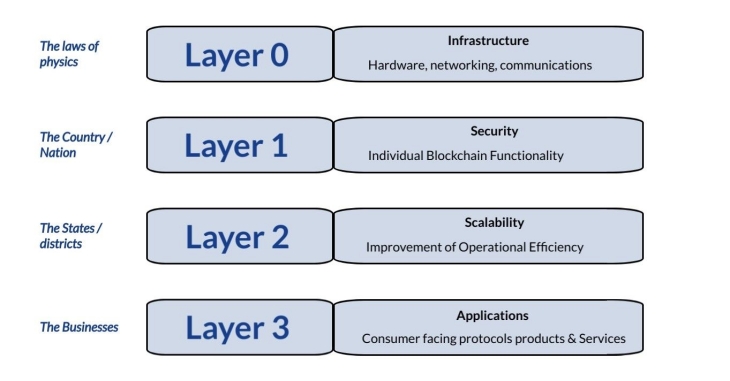Key Takeaways
- A Layer-2 (L2) protocol is a secondary framework constructed on prime of an present, safer blockchain community to make it extra accessible.
- They improve transaction effectivity by offloading the method from the primary chain and have shut similarities to the SWIFT messaging community in TradFi.
- Buyers can spend money on the tokens of those Layer-2 tasks, which they will maintain or stake to determine the long-term winners.
Desk of Contents
- What Are Layer-2s?
- Why Are Layer-2s Essential?
- Layer-2s vs SWIFT
- Prime Layer-2 Blockchains
- The place Are Layer-2 Blockchains Used?
- Investor Outlook for Layer-2s
- Investor Takeaway

Whereas we frequently consider blockchain as a singular know-how, it’s layers of know-how working collectively.
Layers aren’t ideally suited. As soon as we begin attending to increased ranges, we’re, most often, compensating for an absence of scalability with the underlying chain. They’re a hack.
On this information, we’ll clarify what Layer-2s are and the way buyers can take into consideration the last word winners of the Layer-2 race so you may spend money on right this moment’s tokens which might be almost definitely to win in the long run.
What are Layer-2s?
Blockchain know-how consists of 4 layers:
- Layer-0 (L0) contains the web and the {hardware} required to attach and talk throughout networks.
- Layer-1 (L1) refers back to the major blockchain community, like bitcoin or Ethereum, specializing in recording transactions, forming consensus, and sustaining safety.
- Layer-2 (L2) focuses on scaling these options
- Layer-3 (L3) focuses on internet hosting purposes to advertise adoption.
Layer-2 refers to a set of know-how options constructed on prime of layer-1 to cut back bottlenecks (i.e., to assist the underlying blockchain run quicker and cheaper).
They depend on the L1 blockchain for safety and knowledge availability and usually comprise two components: knowledge packets and protocol layer. The place knowledge packets signify the encoded and decoded bits of knowledge, the protocol layer focuses on transferring knowledge from one community section to a different.
Whereas Layer-1 is the inspiration of decentralized finance, Layer-2 blockchain options have been constructed to enhance scaling and compatibility with third-party purposes.
For instance, Ethereum is a well-liked Layer-1, but it surely hasn’t scaled effectively. So Layer-2 options like Arbitrum, Optimism, and Base have been constructed to make Ethereum run quicker and cheaper.
Why Are Layer-2s Essential?
Because the variety of blockchain customers grows, so do their scalability points. Layer-2 blockchains handle these challenges by offloading transactions from the primary chain and processing them individually. Layer-2 networks usually supply:
- Decrease charges: Layer-2 protocols bundle off-chain transactions right into a single Layer-1 transaction, decreasing the info load on the mainnet whereas retaining the advantages of safety and decentralization.
- Extra utility: By permitting for increased transaction throughput, Layer-2 tasks can enhance the consumer expertise whereas specializing in scope and real-world usability.
Think about having to ship cash to a overseas nation within the early 1900s. You’d have to make use of gold or silver forex to buy a financial institution draft that will be honored abroad. You possibly can mail a financial institution draft to the individual you needed to ship cash to.
When SWIFT was invented in 1973, the remittance course of was gradual, reliant on particular person couriers, and liable to delays and loss.
SWIFT stands for The Society for Worldwide Interbank Monetary Telecommunication and is the first messaging community for worldwide funds. Up to now, SWIFT stays the default commonplace for worldwide cash transfers and works by sending essential details about the transaction from one financial institution to a different, together with sender title, recipient, transaction quantity, and forex alternate charges.
Layer-2 blockchains function equally to SWIFT. They construct and enhance present infrastructure to ease the method of sending cash. SWIFT represents a state of affairs the place one Layer-2 blockchain turns into the first resolution to scalability – we’ll all be leveraging a single messaging system to work together with the main community.
That mentioned, key factors additionally differentiate Layer-2 from SWIFT. Layer-2 options are decentralized, that means no central authority oversees their transactions. SWIFT is a centralized system managed by a consortium of banks.
Due to the involvement of a number of intermediaries and the rigorous processes of TradFi, SWIFT transactions take longer to settle than their blockchain counterparts.
Prime Layer-2 Blockchains

Every kind of Layer-2 solves a special ache level. Relying on a blockchain’s or a consumer’s necessities, one Layer-2 resolution could also be higher than others.
- State Channels: A state channel is a blockchain second-layer resolution permitting contributors to carry out limitless non-public transactions off-chain. That is ideally suited for conditions that require frequent, bidirectional transactions, like in-game microtransactions and live-stream donations.
- Optimistic Rollups: To course of transactions faster, Layer-2 options can mixture a number of off-chain transactions into one, assume that they’re legitimate by default, and solely run computations in case of a dispute. That is how optimistic roll-ups function and are good for DApps and DeFi platforms.
- ZK Rollups: Zero-knowledge rollups create safer blockchains than optimistic rollups by compressing transaction knowledge, validating the transactions off-chain, and sending this info to the primary chain. Like optimistic rollups, the sort of Layer-2 is ideal for dapps and DeFi platforms, providing enhanced privateness and effectivity.
- Plasma: Providing the best diploma of safety amongst Layer-2 varieties, plasma chains create a collection of kid chains as secondary chains that help the primary blockchain with verifications, linked by sensible contracts that allow the primary chain to information the kid chains.
- Sidechains: Sidechains are unbiased blockchains that run parallel to the primary blockchain. It’s good for purposes that require customizable options and unbiased governance from the primary chain whereas nonetheless resolving operations on the bottom layer.
The place Are Layer-2 Blockchains Used?
As a result of Layer-2 protocols lengthen the capabilities and scalability of a central blockchain community, they empower these tasks to assist (and disrupt) industries rather more readily. A few of these industries embody:
DeFi
Bettering transaction pace is essential for DeFi, particularly in buying and selling, the place well timed execution is the distinction between earnings and losses. Loopring, for instance, makes use of ZK-Rollups to facilitate high-speed trades and transfers for his or her merchants.
Dapps
With batch processing and enhanced interoperability, dapps might course of extra transactions throughout many purposes. Polygon is a Layer-2 scaling resolution that enables dapps to perform throughout totally different blockchain platforms with out compromising efficiency.
Micropayments
As a Layer-2 resolution lowers common transaction charges, micropayments come at a a lot decrease value for customers. Gaming ecosystems and reside streamers can use this characteristic for monetization functions or pay-per-use fashions.
Investor Outlook for Layer-2s
The historical past of know-how can provide us some clues as to how the Layer-2 race will play out.
Sometimes, a brand new know-how sees an explosion of latest opponents (serps, social media websites, and so on.), which step by step coalesce into a couple of eventualities:
-
Monopoly: You will have one dominant resolution that beneficial properties a lot of the market share as a result of it turns into too inconvenient to make use of anything. (Suppose Google in search.)
Beneath this state of affairs, one massive Layer-2 will dominate every of the first Layer-1 blockchains. (And there could solely be one major Layer-1 blockchain as effectively.) On this state of affairs, the present winners can be Ethereum (ETH) and Polygon (MATIC), so buyers would modify their bets accordingly.
-
Oligopoly: You will have two or three dominant options that successfully crowd out the remainder of the market (suppose Apple and Home windows or iPhone and Android).
Just a few Layer-2s might survive on this state of affairs, every providing considerably totally different developer advantages. For buyers, the Layer-1 wager would nonetheless in all probability be Ethereum (ETH), however the Layer-2 bets would nonetheless be too early to inform.
-
Disruptive Know-how: Typically, the elemental know-how modifications or is disruptive. (Disk drives, CD-ROMs, digital music shops, and so on.).
No Layer-2 could win out on this state of affairs as a result of Layer-1s determine a option to turn into extra scalable with out them. Ethereum (ETH) can be the first long-term funding on this case.
In the interim, Layer-2 options are including worth. However it’ll probably be a winner-takes-all or a winner-takes-most consequence. Except, in fact, Layer-1s enhance considerably, rendering Layer-2s nugatory.
Investor Takeaway
For buyers, Layer-2 options current each alternatives and challenges.
An clever investor ought to analysis the distinct options of every Layer-2 resolution, however extra importantly, their market traction. Are they attracting actual customers – not simply buyers hoping for the airdrop, however actual customers utilizing them and actual builders creating on them?
That is the early days for Layer-2s. Sooner or later, they may both consolidate or be rendered out of date. High quality Layer-1s like Ethereum are nonetheless probably the safer funding for many buyers.
Subscribe to Bitcoin Market Journal to maintain up with all of the layers of blockchain investing.






